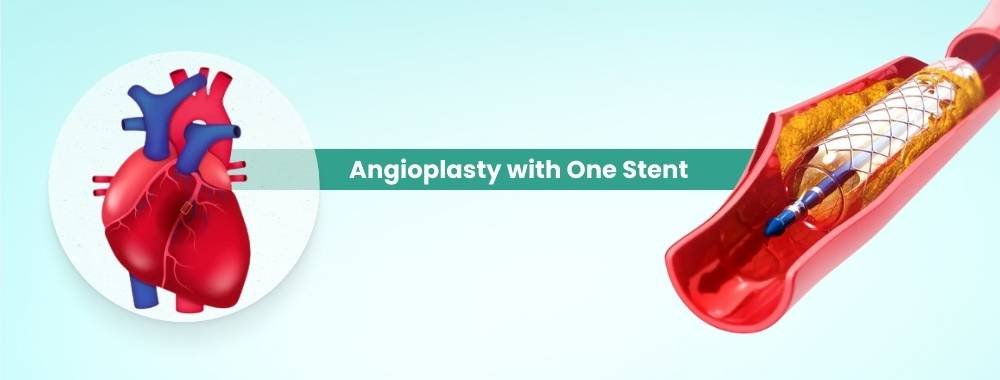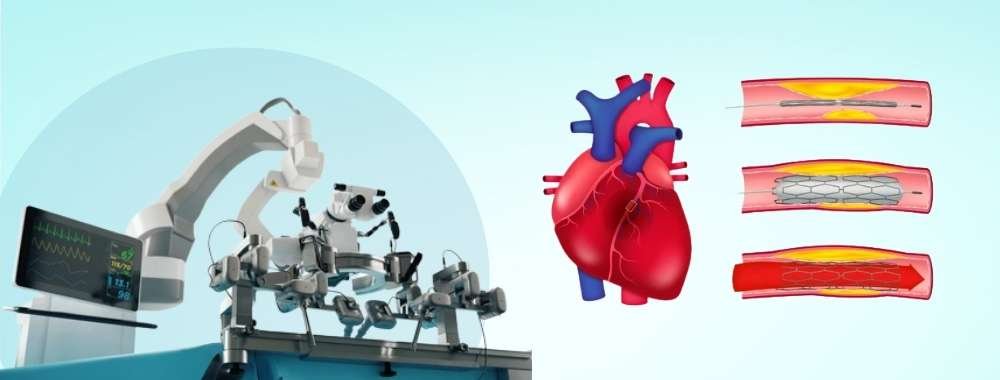Get affordable angioplasty with one stent in India, where experienced cardiologists use advanced techniques to restore heart health. Benefit from world-class treatment options at an affordable cost compared to other countries.
Recovery Time
10 Days
Success Rate
98%
Hospital Stay
2 Days
Treatment Type
Surgical
Home Treatments Cardiology Angioplasty with One Stent
Are you experiencing chest pain, shortness of breath, and discomfort in the arms and legs while seeking affordable and advanced medical options?
Angioplasty is a procedure that opens narrowed and blocked blood vessels supplying blood to the heart, These blood vessels are called coronary arteries.
It's important to know about this problem and stay away from it if you are planning to come to India.
India is a leading destination for international patients seeking high-quality and affordable angioplasty services. The country has many highly experienced and board-certified cardiac surgeons who implement advanced medical techniques, ensuring they deliver personalized care and successful outcomes for patients from around the globe.

Angioplasty, also known as balloon angioplasty, is a medical procedure that helps open blocked and narrowed arteries. Doctors use it when fat and cholesterol buildup make it difficult for blood to flow through the arteries.
Angioplasty is a minimally invasive procedure in which doctors do not need to make large cuts; they insert a thin tube with a small balloon at the tip into the blocked artery, making more space for blood to flow. Doctors often place a stent inside the artery after angioplasty, then the stent keeps the artery open and reduces the chance of it becoming narrow again.
In India, angioplasty has improved remarkably over the years with some advanced achievements. The first coronary angioplasty was done at Apollo Hospitals in Hyderabad using an advanced absorbable stent called the Bioresorbable Vascular Scaffold (ABSORB – BVS), and this stent dissolves naturally over time.
Dr. Tejas Patel, a senior cardiologist in Gujarat, gained attention for performing the world's first telerobotic angioplasty from 32 kilometers away. This new technology makes healthcare treatments easier to access and more accurate.
Angioplasty improves blood flow and helps keep your organs healthy.
When the arteries supplying blood to your heart get blocked, your heart doesn't get enough oxygen, which can cause chest pain and a heart attack. Angioplasty helps clear the blockage, improving heart health.
If arteries in your legs, arms, and pelvis are blocked, it can cause pain, weakness, and trouble walking, Angioplasty helps restore proper blood flow to these areas.
The carotid arteries in your neck supply blood to your brain. If they are blocked, your brain may not get enough oxygen, which increases the risk of stroke. Angioplasty can open these arteries and improve blood flow.
When arteries cause your kidneys to be blocked, your kidneys do not get enough oxygen which can affect their function. In some cases, angioplasty helps improve kidney health by restoring blood flow.
Fill in your details and we'll get back to you soonGet Free Treatment Quote
Stents are small tubes placed in arteries to keep them open and improve blood flow. There are three main types:
Bare metal stents made of stainless steel and cobalt chrome provide permanent support to the artery and help reduce heart disease.
Drug-eluting stents are coated with medicine that helps prevent scarring and future blockages.
It slowly releases medication to reduce inflammation and improve blood flow, mostly it is useful for more complex cases and people who already had stents before.
It is made of magnesium alloy and dissolves in the body within two years and it opens blocked arteries and then disappears naturally. This type of stent is not suitable for elderly people with chronic arterial.
If your heart arteries are blocked, you may need to change your diet, exercise, and take medicine. But if these steps do not work, your doctors may suggest angioplasty to open the arteries and prevent further problems.
If you have chest pain, angioplasty might be needed and your doctors may try medicine first, but if the pain continues, then, a stent can help improve blood flow.
After a heart attack, angioplasty can quickly clear the blockage and restore blood flow, it needs to be done fast to prevent further damage to your heart muscle.
If you have health problems like diabetes, a weak heart, and severe artery blockages, angioplasty might not be the best option for you.
In this case, doctors may suggest a different treatment called coronary artery bypass surgery. It uses a healthy blood vessel from another part of your body to create a new path for blood to flow around the blocked artery. This helps restore proper blood flow to your heart and reduces the risk of a heart attack and other serious problems.
The total angioplasty stent cost in India usually includes surgical fees, hospital charges, use of the operating room, and nursing care, there are extra costs like diagnostic tests, medications, rehabilitation after surgery, and follow-up appointments.
Cost Component | Details | Estimated Cost in USD |
Pre-operative Consultation & Diagnosis | Consultations, X-rays, MRI scans, blood tests. | 400 USD |
Surgery Costs | Includes surgeon fees, hospital stay, and type of surgery. | 3800 USD |
Rehabilitation and Follow-up | Physiotherapy sessions, medications, supportive devices, and follow-up visits. | Variable for procedure |

The angioplasty stent cost in India widely depends on various factors. Here are some of the important factors that impact the cost:
Tests like angiograms, blood tests, and other preliminary examinations add to the overall cost of surgery.
The total cost of surgery depends upon the experience of cardiologists and their reputation because surgeons with higher experience may charge more.
The cost of a heart stent depends on the type of stent used:
Bare-metal stents (BMS) are generally cheaper compared to other types. Drug-Eluting Stents (DES) are more expensive as they release medication to prevent artery blockage and Bioabsorbable Stents are newer and costly because they are designed to dissolve over time.
Stents from famous brands are usually more expensive than those from smaller and local brands, this is because of differences in quality, research and development costs, and manufacturing expenses, which affect overall cost.
The total cost of the procedure may increase if additional treatments and complications are needed, which include emergency care, extra stents, and angiography.
The cost of stent placement depends on the use of advanced technology and techniques. Hospitals that offer advanced treatment options may charge more.
Complex cases in which patients with multiple health issues and complications may require more extensive care, which affects the cost of treatment.
The overall cost can be impacted by additional charges for prescription drugs, hospital stays, follow-up visits, and rehabilitation as well.
Country | Angioplasty Stent Cost Structure |
India | 3800 USD |
United States | 28000 USD |
Germany | 17000 USD |
Turkey | 4000-5000 USD |
◾Key Takeaways
✅ Affordable Surgery Costs: India provides affordable healthcare with expert surgeons, the country has modern facilities that deliver high-quality heart care for international patients.
✅ Advanced Medical Technology: Hospitals in India are equipped with innovative technology and have modern infrastructure and high-quality care for international standards at more affordable costs.
Angioplasty with One Stent cost
Treatment Name
Estimated Cost
Angioplasty with One Stent 3800 USD
India is known for delivering high-quality healthcare at much lower costs compared to Western countries. The country has advanced medical technology and skilled heart specialists, making it the best place for heart care.
Many Indian hospitals are accredited by global healthcare organizations like NABH, and JCI which ensure top standards of care.
The cost of heart procedures is very affordable because of different stent options, However, patients benefit from special healthcare packages that include accommodation, transport, and rehabilitation services, follow-up care.
Heart treatments like angioplasty are very expensive in other countries. That’s why many patients from Saudi Arabia, Qatar, Kenya, Nigeria, Rwanda, and Uganda choose India for excellent and affordable heart care.
Thanks to India’s modern hospitals, highly experienced doctors, the latest medical innovations,
complete patient care, and affordable cost, India stands out as a top choice for medical treatment.
India has many highly skilled cardiac specialists who specialize in performing angioplasty and effective treatments aimed at delivering advanced and specialized medical care to patients.
Indian hospitals deliver innovative technology and high-quality care and they support recovery based on each patient.
Blood tests are performed for general health checkups, blood clotting ability, and potential risks related to medications and allergies.
To detect the electrical rhythm of your heart and identify any abnormalities like arrhythmias.
To evaluate the structure and function of the heart, like the pumping ability of the heart chambers.
Chest X-ray helps to identify any lung abnormalities that could impact the procedure.
This is the primary diagnostic test where a catheter is inserted into an artery in your wrist, and a contrast dye is injected to see the coronary arteries and identify blockages.
To examine the response of your heart and identify potential areas of reduced blood flow.
To measure pressures within the heart chambers and see blood flow.
A non-invasive imaging technique helps to see the coronary arteries.
Magnetic resonance angiography uses magnetic fields instead of radiation.
🟢Do’s Before Surgery
✅ You should stop taking medications like blood thinners and nonsteroidal anti-inflammatory drugs (NSAIDs), you should also avoid diuretics and ACE inhibitors.
✅ You must avoid eating and drinking anything before your surgery.
✅ You may be instructed by your doctor to wash yourself with a special antibacterial soap the day before and the day of surgery.
✅ You must try to improve your mood by doing something active, you can also try meditation to relax your body.
🔴Don’ts Before Surgery
❌ You must avoid drinking alcohol at least one week before surgery and quit smoking at least two weeks before.
❌ Avoid wearing makeup, perfume, deodorant, hairspray, and any other cosmetics on the day of surgery.
❌ If you use a wig, hairpiece, and hair extensions, you will be instructed to remove them.
❌ Do not smoke and use tobacco the previous day of the surgery to reduce the risk of blood clots.

Angioplasty in India has made great progress with new technologies that improve patient safety and success rates. Here are some of the most important advancements:
This technique uses a laser to remove blockages inside arteries, especially helpful for tough blockages and for clearing clogged stents and this method has become safer and more effective.
Doctors now use special imaging techniques like Intravascular Ultrasound (IVUS) and Optical Coherence Tomography (OCT) to get a clear, detailed view inside the arteries and these images help doctors place stents more accurately and improve treatment results.
India is leading in robotic-assisted angioplasty. In a groundbreaking case, a doctor performed the world's first remote angioplasty on a patient 32 km away using a robotic arm controlled through the internet. This technology makes procedures more accurate and could help patients in local areas.
Unlike traditional metal stents, these stents dissolve with time, reducing long-term complications and they provide support to arteries during healing but disappear once the artery regains its normal function.
These drug-coated balloons release medicine directly into the artery wall during angioplasty, helping to prevent blockage. In some cases, they can be used instead of stents, reducing risks and complications.
The Procedure of Angioplasty with One Stent
Before Angioplasty
During Angioplasty
After Angioplasty
The benefits of angioplasty and stenting depend on how serious their heart condition is, their age, and overall health.
Your doctor will tell you when you can start moving around after angioplasty. In most cases, you should rest for at least two days before standing and walking for a long time. After that, you can do light activities like short walks, you may feel more energetic because your heart is working better. However, avoid heavy exercise for 30 days.
Fill in your details and we'll get back to you soonGet Free Treatment Quote
Best Sleeping Positions for Recovery
If you have angioplasty, it's still important to take steps to reduce your risk of having further problems, including:
Angioplasty is a safe and effective procedure, but like any surgery, it has some risks. However, serious complications are very rare.
Hospital Stay and Recovery Time
After angioplasty, you’ll likely stay in the hospital for 2 days. Depending on your health and self-care, your recovery period will be about 10 days.
Angioplasty in India offers a 98% success rate, providing remarkable treatment options with proper post-surgery care.

All medical procedures have some risks, with angioplasty and stenting, common problems can include:
Why Choose Mejocare for Angioplasty with One Stent in India?
✅ Team of Top Cardiologists, Cardiac Surgeons: Our recommended surgeons have over 25 years of experience in performing angioplasty and other complex heart procedures which means you will receive high-quality care from experts who understand your heart condition.
✅ JCI/NABH Accredited Hospitals: Mejocare partners with hospitals that are accredited by JCI and NABH. These hospitals feature advanced facilities and the latest technologies, such as robotics, minimally invasive heart surgery, machine learning, and advanced diagnostic and therapeutic equipment, delivering complete and personalized care.
✅ Other Benefits: We deliver fast, detailed responses, exact cost estimates, and assistance with obtaining medical visas, as well as accommodation arrangements in India. Additionally, we prioritize your appointment scheduling and provide smooth arrival services, including airport pickup, hotel transfers, and full support during your hospital stays.
Angioplasty helps clear a blocked artery and improves blood flow. Even if the procedure is successful, it's important to stay healthy, take your medicines as prescribed, and visit your doctor for follow-ups. This will help keep your heart strong and prevent future problems.
Disclaimer
Given details in this article are only for general purposes it doesn’t aim to provide an exact cost estimate. If you are seeking professional opinions and exact cost estimates we can help you to connect with India’s top surgeons. Contact Mejocare now.

Medically Reviewed By
Qualifications
Dr. Aryan Malhotra is a skilled and caring doctor. He is a Radiation Oncology Resident at Burdwan Medical College and Hospital. He treats people with cancer and works closely with patients during their treatment.
He completed his MBBS from David Tvildiani Medical University in Georgia. He has passed the USMLE Step 1 exam, which shows his strong medical knowledge.
Dr. Aryan is registered with the West Bengal Medical Council. His medical registration number is 95565.
At Mejocare, Dr. Aryan reviews health content to make sure it is correct and easy to understand. He helps people get clear and trusted medical information.
He is known for being kind, patient, and professional. He listens carefully and gives honest advice. His goal is always to provide the best care to his patients.
Dr. Aryan is a trusted part of the Mejocare medical team. He brings strong knowledge and real care to everything he does.
Certifications
Accomplishments
Affiliations
The cost of angioplasty with one stent is 3800 USD, depending on the type of stent used and the hospital's location.
The success rate of angioplasty with one stent is 98% in India.
Recovery time is typically around 10 days for most patients, but it varies based on individual health and complications.
There are mainly two types of stents such as bare-metal stents (BMS) and drug-eluting stents (DES). however, DES are more expensive but have a lower risk of restenosis.
Additional costs may include hospitalization charges, pre-surgery diagnostic tests (like angiography), follow-up consultations, and post-surgery medications.
Risks include bleeding, infection, artery damage, or re-narrowing of the artery. However, these risks are generally low with proper care.
Our care team can help you.
